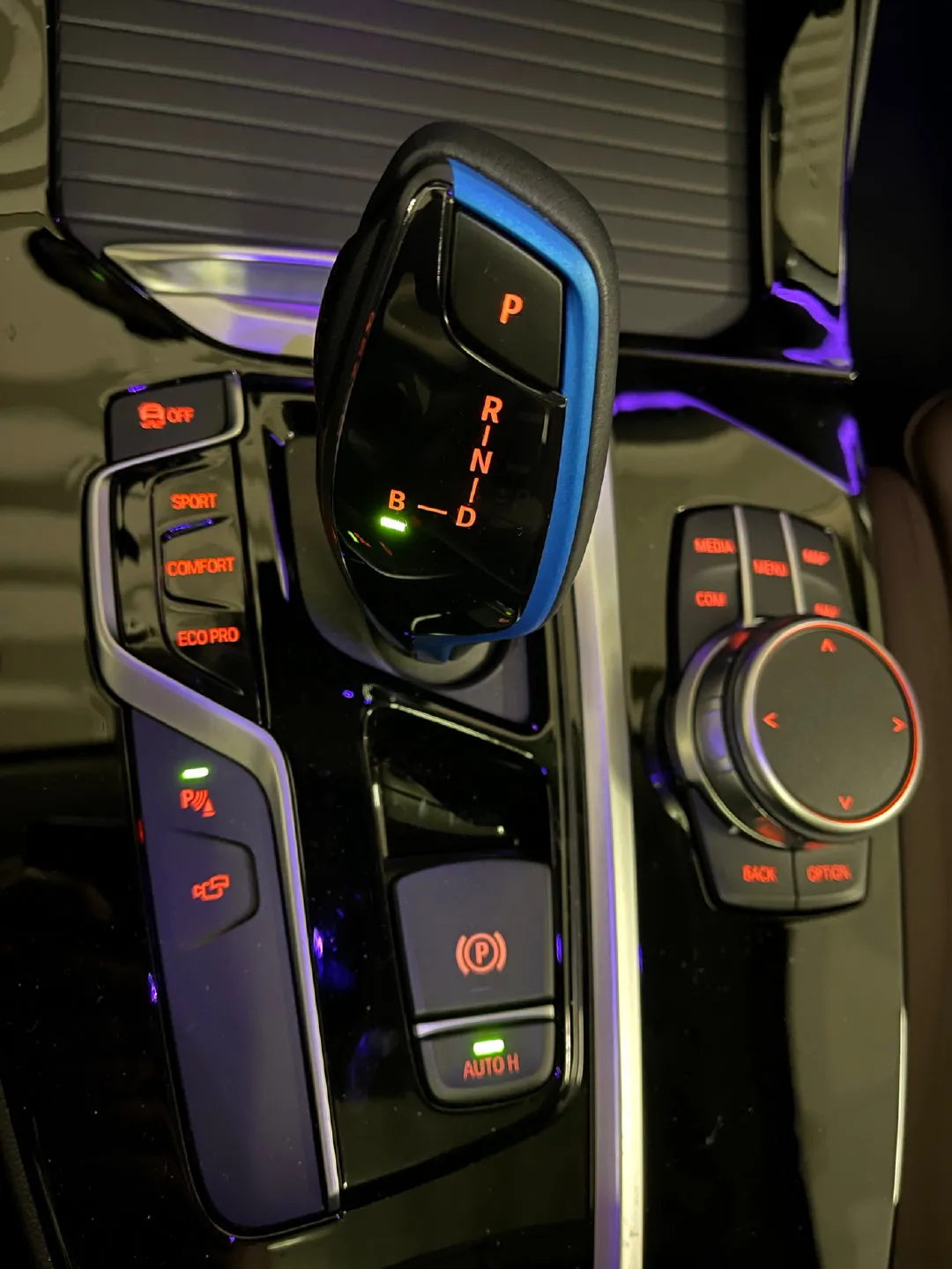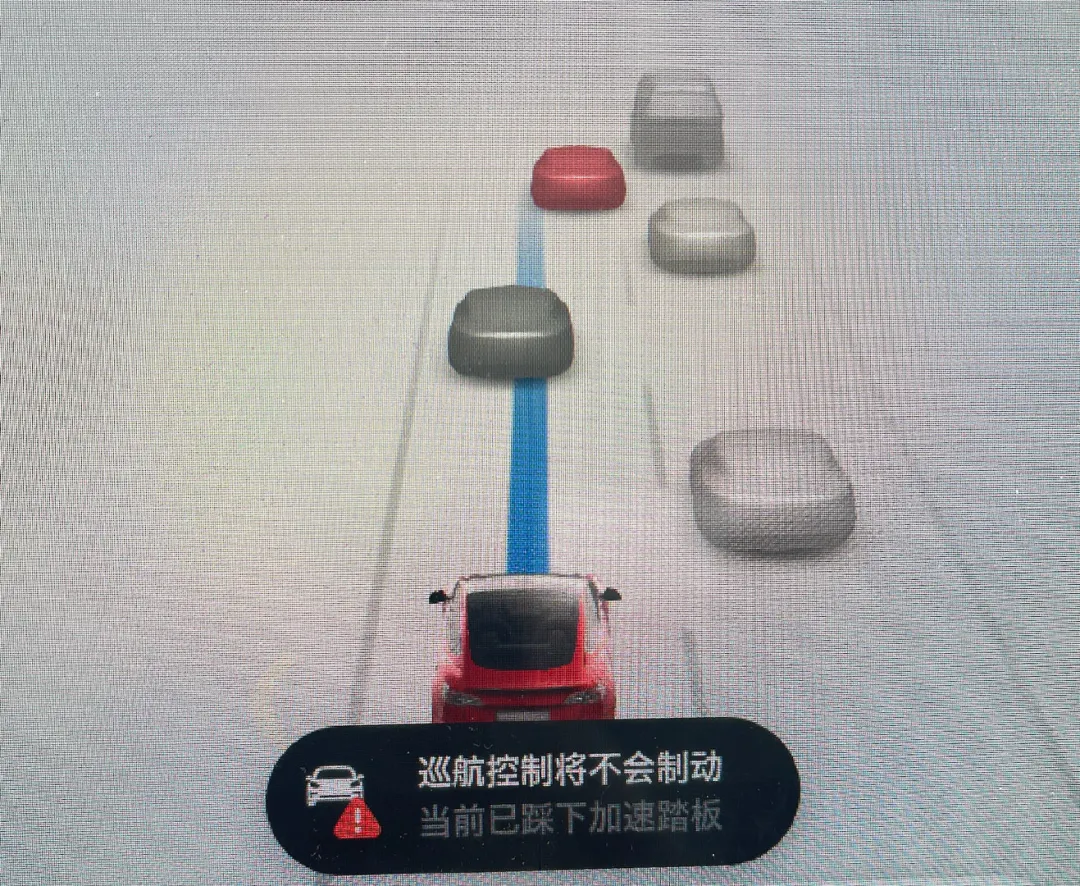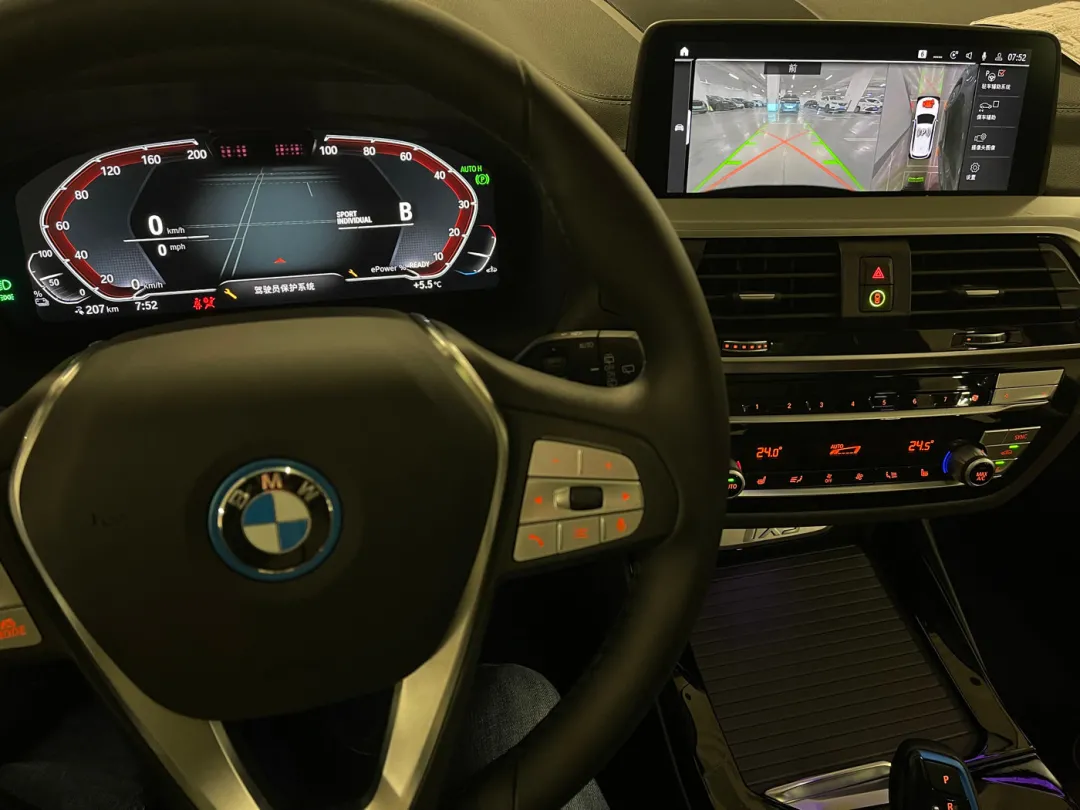Before test driving the iX3, my impression of it was entirely based on the comparison article of iX3, ES6, and Model Y on Autohome, where iX3 appeared to be expensive with no features, inferior performance in terms of technical specifications, and mediocre product strength, thus its poor sales were entirely expected. However, the actual highlights of iX3 are difficult to discern without a test drive, and these highlights are not easily reflected in the comparison article. I do not aim to denounce the article on Autohome. In fact, the article is very objective and has considerable reference value. However, the subjective evaluation is limited, varies from person to person, and may not be generally representative. Therefore, personal test driving is crucial in the process of car selection and purchase, and our own feelings matter.
Single-pedal mode of iX3
Tesla Model 3, the current leader in single-pedal driving, comes to mind when people talk about single-pedal driving. In fact, the pioneers of single-pedal driving are BMW i3, General Motors Bolt, and Nissan Leaf (not sure which one was the earliest, but they were all among the first electric cars). Therefore, Tesla is still the younger sibling in terms of single-pedal mode. BMW has richer experience in this regard, and iX3 even has a separate gear for single-pedal driving:

On the iX3 gear shift lever, on the left of D gear, there is a B gear that is usually a manual gear in cars equipped with an automatic manual transmission. The B gear is the single-pedal driving mode of iX3, and regardless of whether Sport, Comfort or Eco Pro is selected, single-pedal driving is achievable in this gear.
To explain briefly what single-pedal driving is and how it differs from strong regenerative braking: when the accelerator pedal is released, most electric vehicles do not go into neutral but allow the vehicle’s inertia to drive the motor to generate electricity, which is then stored in the battery. At this stage, the vehicle produces a moderate braking feeling. This stage is called regenerative braking. When the vehicle speed drops to a single-digit number, the drag effect of regenerative braking will be very weak, and most vehicles will continue to coast at idle speed. However, in cars that support single-pedal driving, the system will automatically engage the mechanical brakes seamlessly until the vehicle comes to a complete stop. Therefore, the difference between single-pedal driving and strong regenerative braking is that with a single-pedal, the vehicle can come to a complete stop after the accelerator pedal is released, while strong regenerative braking still requires stepping on the brake pedal.
In most cases, single-pedal driving can control the vehicle speed without having to step on the brake pedal, only by opening and closing the accelerator pedal. However, as strong regenerative braking only has moderate braking effect, it is necessary to step on the brake pedal in case of emergency braking needs.The single pedal mode of iX3, which is the connection between regenerative braking and mechanical braking, is smoother than that of Tesla. The connection between regenerative braking and braking in Tesla’s stopping mode is not stable. I have not figured out the rule. Sometimes it is smooth, and sometimes there is some pulsating jitter, like the feeling of manual braking. The performance of iX3 has always been stable, and I can’t even feel the intervention of mechanical braking when it stops firmly.
However, the disadvantage of iX3 is also obvious, which is that the intervention of regenerative braking after releasing the accelerator is too direct. The instant regenerative braking intervenes at full power, and the initial braking feeling is stronger than Tesla’s (abrupt). The intervention of regenerative braking in sports, comfort, and energy-saving driving modes with B gear is also abrupt, and the difference between sports and comfort is small, with energy-saving being slightly better. This abrupt feeling is not good, but I have a strong adaptation ability. I just need to release the accelerator slightly to eliminate this abrupt feeling.
The intervention feeling of Tesla’s regenerative braking is the best. There is a short linear increase process before the sports mode intervenes the fastest, so it feels good when you release the accelerator directly. The slow intervention of Tesla’s comfort mode is very friendly to passengers, and iX3’s energy-saving mode can’t compare.
The same problem also occurs in the initial stage of iX3’s acceleration. The sports mode is very sporty, and the dynamic response of the throttle is even more direct than that of Tesla. Although the hundred-kilometer acceleration is slightly weaker, the initial pushing back feeling is particularly strong, similar to the ideal ONE’s ejection start mode. I personally like this setting. But the comfort mode is not comfortable enough. The throttle response is still too direct, and there is not much difference from the sports mode. The energy-saving mode is relatively the most comfortable, but you can also clearly feel that the throttle is not linear enough, not as good as the comfort mode of the ideal ONE and Tesla.
The acceleration response and regenerative braking intervention of iX3 are too direct. I don’t know whether it was intentionally calibrated like this or not calibrated well. I tend to be the latter. There is no problem with calibrating the sports mode like this, but if the comfort and energy-saving modes are also so direct, passengers will have a hard time.
Adaptive regenerative braking of iX3
Although there is a problem with the calibration of iX3’s strong regenerative braking, fortunately, BMW does not force you to adapt to it like Tesla’s new cars, which only have a strong regenerative braking mode. The D gear of iX3 can customize the strength of regenerative braking, with high, medium and low three gears to choose from. What’s more powerful is the adaptive regenerative braking, which allows the system to automatically judge what strength of regenerative braking is needed at the moment, which is very interesting. The aim is to solve the biggest pain point of regenerative braking, which I have mentioned in many other blog posts before:
There is a situation where single pedal driving can be tiring, that is, when driving at a constant speed such as on the highway, you need to half-press the accelerator at all times to control the speed accurately. If the accelerator is lifted slightly, the speed will be reduced. The accelerator of petrol-powered cars does not need to be precisely controlled, intermittent pressing, or even complete release of the accelerator for a short slide is not a problem. Fortunately, this situation is the best use case for adaptive cruise control/ driver assistance. Let the computer control the speed accurately and take a break.I think this pain point can be solved by ACC/ADAS, but there are limitations to the use of ADAS. BMW is also trying to solve this by using the radar camera of the ADAS system to determine the distance to the preceding vehicle. If there is no vehicle in front or the distance is far, releasing the accelerator pedal will completely deactivate energy regeneration, resulting in a neutral coasting state. If there is a vehicle in front, releasing the accelerator pedal will activate energy regeneration, and the closer the distance, the stronger the energy regeneration force.
Adaptive energy regeneration with varying degrees of force not only requires an understanding of its working principles, but also some time to adapt. Overall, it is a very good idea and deserves praise for BMW’s innovation. I did not have enough time or different road conditions to adapt and experience this feature during the test drive, so I cannot evaluate its merits for now.
ADAS of iX3
BMW’s ADAS system has always been good, and its basic L2 level experience is comparable to Tesla and other new players in the industry. It has always been in the first echelon among traditional automakers, mainly due to its deep cooperation with Mobileye. Previously, when the European NCAP scored autonomous driving, BBA scored the highest, while Tesla ranked lower. At that time, I thought this was a score fixed by Europeans. It was not until I test-drove the iX3’s new automated driving Pro system that I realized that if evaluated by different standards, iX3 does indeed have unique features and is more user-friendly. The following are its highlights:
-
The automatic acceleration and deceleration of ACC is very gentle and feels like a seasoned driver who cares about the passenger experience. This is a bit fleshy, but it is really comfortable and the experience is the best. Don’t expect ACC to closely follow the preceding vehicle and prevent side insertion in congested road sections. It is not realistic for ACC to respond faster or slower, so I think it should go in the comfortable direction.
-
The experience of the lane changing function with the turn signal is also very stable and feels good, but it can only be used at speeds above 70km/h.
-
The capacitive sensing steering wheel is particularly impressive. When ADAS is turned on, it only takes one finger to lightly rest on the steering wheel, and frequent turning of the steering wheel is not necessary, which is particularly pleasant. This sensing is even more sensitive than the ideal ONE’s steering wheel.
The above are all small functional points and not the focus. The biggest highlight is the human-machine integrated ADAS switching logic.4. This set of ADAS also provides automatic low-speed driving function in congested road sections, where drivers can release the steering wheel and relax. However, due to national conditions, this function is basically unusable. Anyone attempting to use ADAS to take a break from driving in congested road sections will be cut off by neighboring vehicles, leading to collision warning, emergency braking, and alerts from cars behind. The root cause is that the ACC following distance is too long. To ensure safety, ACCs of almost all vehicles leave at least one vehicle body length as following distance. However, leaving such a large following distance in China is a temptation for neighboring drivers to cut in.
What can be done? When I drive my Tesla, I sometimes do this: I use ADAS while lightly stepping on the accelerator to reduce the following distance and avoid being cut off. At this point, there will be a situation where human and machine are competing for control. The machine thinks that the following distance is too close and unsafe and reminds the driver that the AEB is temporarily unavailable (disclaimer: if you rear-end someone while stepping on the gas pedal, it’s your own fault, not mine). If the distance is still too close, release the accelerator. Once the machine realizes that the control has been given back to the driver, it will step on the brake to prevent a rear-end collision. In short, switching back and forth between ACC and manual accelerator control is not smooth and the experience is very poor.

On the other hand, the ACC of iX3 is not like this. Stepping on the gas pedal shortens the following distance, while releasing the gas pedal allows energy recovery to slow down and increase the distance. The braking is not abrupt, and the ACC does not exit. The logic is that if you want to step on the accelerator, you can do so. If you don’t want to, the machine immediately takes over. However, if you don’t step on the brake, the machine won’t either. This method is mainly designed to be more in line with the driver’s wishes, and the human-machine switching experience is better.
- The logic of switching and restoring between manual lane change and lane keeping is similar to that of ACC. After changing lanes, it will automatically restart at a suitable time, without the need to repeatedly exit/restart. Therefore, the vehicle can basically remain in the lane-keeping state throughout the journey. If you want to change lanes to overtake, you can do so and the ADAS will automatically restore after you finish overtaking. This feeling is very comfortable. With my impulsive driving style, the conventional L2 ADAS, plus lane change signals and even NOA/NXP, are very annoying when there are many cars on the road. The machine is too indecisive (fleshy). I only use ADAS or NOA when the road is clear; otherwise, I drive myself because it’s much faster.Translation:
Tesla and BMW’s Different Approaches to Autonomous Driving
Tesla and most autonomous driving systems have the logic of either machine driving or human driving, while BMW’s logic is that even after the use of autonomous driving, you can drive at any time. You can control the distance and speed of the car by yourself, turn the steering wheel to change lanes or overtake, and when you’re finished with the complex operations, such as maneuvering around or overtaking other vehicles on the highway, the autonomous driving resumes immediately with almost seamless takeover. It feels like a “man-machine integration,” where humans are responsible for complex operations such as competing with other vehicles or overtaking, while the machines are on standby to handle simple driving.
I drive over 100 kilometers to and from work every day, mostly on the six-ring and highways that are very friendly to autonomous driving. However, I rarely use the autonomous driving / NOA function because the machine is slow, not relaxing, and somewhat dangerous. Now, the media evaluates the autonomous driving system, focusing on NOA. Although NOA is important and is the only way to fully automated driving, the basic L2 autonomous driving system, which has a stronger practicality, is equally important.
BMW’s autonomous driving system hardware is actually quite strong and, theoretically, can support functions similar to NOA. However, BMW has provided another idea that combines human driving and autonomous driving perfectly, which makes the availability and practicality of autonomous driving better at this stage. I quite like this model.
Looking back at the E-NCAP rating for autonomous driving systems, Tesla’s vehicle assistance score is still far ahead. The disadvantage is that the driver’s participation is the lowest, which is indeed the case. Machines can never replace humans, and until L4 level maturity, L2 level human-machine combination is the best. The design concepts of the autonomous driving system are different, and there is no difference between good and bad. I believe Tesla can achieve the same results through OTA, but it simply doesn’t want to.
Other
The iX3 chassis is very comfortable, with a moderate hardness (between ideal ONE’s sportiness and comfort, softer than Model 3/X), and very stable at high speeds. When encountering uneven roads, it’s slightly shaky, without excessive bounce and comfortable in absorbing shocks. It’s the most comfortable electric car I’ve driven. Although the Tesla chassis is slightly harder and there’s no excessive bounce, the shock of the bumpy roads is greater.
The car’s functionality, menus, and interaction logic are a mess and difficult to use. It’s quite frustrating to look for specific settings. The interaction experience feels like it’s from last century. Fortunately, it supports Carplay, and multimedia functions can be achieved through the phone.
Many people think that BMW will tune iX3 to be a hybrid car-like electric vehicle. In fact, it’s the exact opposite. This car is very electric. Note that this sentence is neutral. Being like a hybrid vehicle is sometimes a compliment as it refers to comfort, which is difficult to achieve.Overall, iX3 exceeded my expectations, but many of the feelings in this article are subjective. I think it’s interesting, so I’m sharing it. The comprehensive product strength of iX3 is different in everyone’s mind, so it’s important to learn and test drive it yourself.
This article is a translation by ChatGPT of a Chinese report from 42HOW. If you have any questions about it, please email bd@42how.com.
